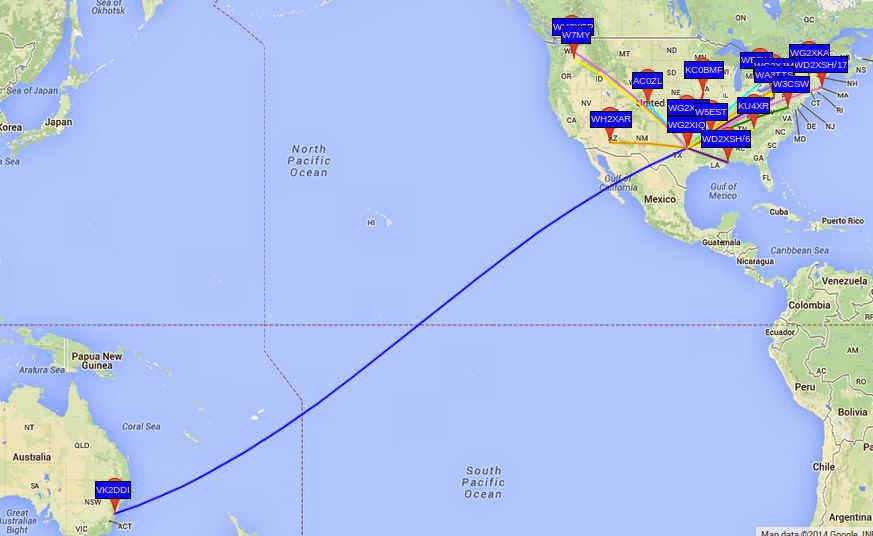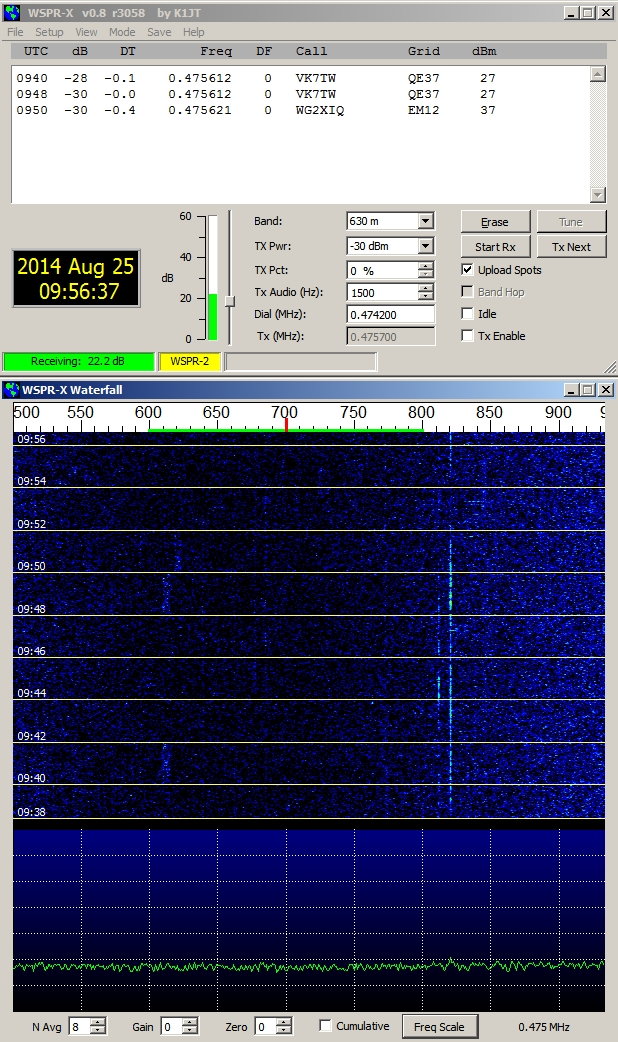 Some radio but a lot of photograpy!
Some radio but a lot of photograpy!
 |
| RAF SE5 flying past CN Tower |
 |
| Me on the Island telling Julie I think I see a plane finally |
 |
| C-123 buzzing a condo about 1/2 KM away |
Mike Weir, VE9KK, is a regular contributor to AmateurRadio.com and writes from New Brunswick, Canada. Contact him at ve9kk@hotmail.com.
 High-Flying Hams
High-Flying Hams

My 'wow-meter' was recently pegged when learning the details of some noteworthy amateur radio activities. Two of these events described the astounding results of "floater balloon" activity.
One such device was launched in mid-July from Victoria state, Australia, by VK3YT, Andy Nguyen. His balloon was given the callsign of VK3YT-8, as it carried amateur radio tracking gear capable of transmitting its location and other data via APRS packets.
The small balloon travelled across the South Pacific and reached the coast of South America in less than a week! From what I can determine, it was last heard from on July 21st....29,000' above central Brazil and heading for the Atlantic Ocean at 69MPH where, I presume, balloon #8 met its demise.
It looks like Andy has just launched VK3YT-12 whose predicted path may be viewed here.
Although Andy's systems are very sophisticated, they are based on small 'Party Foil' balloons carrying small antennas and around a 12 gram, 10mw electronic payload.
 |
| VK3YT-11 Last heard from off the Brisbane coast |
Tracking is via VHF APRS packet dumps (some even going via the ISS) and telemetry data via THOR16 or OLIVIA digital modes. Some use rechargeable batteries while others seem to be completely solar powered. Unfortunately I am dreadfully ignorant when it comes to APRS and many of the new digital modes. There is very little detailed information on Andy's onboard hardware, all of which seems to be homebrew.
Many of the balloons appear to float in wide circles a few hundred miles from their release points while others are immediately pushed northwards and out to sea....some quickly reaching New Zealand. Balloon #8 has been the biggest success to date.
You can follow VK3YT's pico progress from balloon #1 to the present, via the VK3YT Blog....what a wonderful example of amateur radio experimental fun!
*****
On the other side of the world, another ardent pico-ballooner is Leo Bodnar, MØXER, who has been launching similar small balloons from near London.
Leo's first payload, B-1, was released in June, 2013 and reached an altitude of almost 36,000 before bursting and returning to earth where it was successfully recovered.
 |
| MØXER launches B-1 |
Launched July 12, 2013, the homemade plastic balloon took off like a rocket, circumnavigating the entire globe in 19 days and passing within 9km of the North Pole and almost overflying the launch site on it's second trip! A few minutes before today's posting, the balloon (at 40,000') has just overflown Murmansk and is now over the Barent Sea, heading northeast at 52MPH. Progress can be tracked from here. He has now had three balloons circumnavigate the globe, with the last two losing contact on their second round as they approached Japan.
Personally I find these results astounding and am so impressed with the sophisticated systems that these very knowledgeable amateurs have been able to pack into such a small payload.
You can follow the interesting progress of Leo's work at his Balloon Flights website.
One thing I am not totally clear about is the actual onboard hardware....is everything scratch-built or are they using readily available modules? I suspect the former in which case I would love to see details of the actual circuitry being employed. As well, there seems to be a variety of different telemetry systems being used with some preferring to store packets until within range of a suitable download link while others rely on amateurs around the world to track, record and decode the digital beacon information...all fascinating stuff.
Kudos to Leo and Andy and all of the others for such well-executed and interesting radio projects. There seems to be a growing worldwide interest in amateur radio balloon projects and a search of the web has provided enough bedtime-reading for weeks. One thing for certain is that all of these fellows are very...very...digital-savvy which likely lets me out of the picture.
Maybe there are some nice low-tech balloon ideas for folks like me, floating around out there!
Steve McDonald, VE7SL, is a regular contributor to AmateurRadio.com and writes from British Columbia, Canada. Contact him at ve7sl@shaw.ca.
 A summer outside
A summer outside
During the week I took a trip with 3 other members of the Workington Amateur Radio Club (MX0WRC.org) to the Furness Amateur Radio Club. A short hours drive away courtesy of Barry, G0RZI. There was a 2 pronged attack on their club, firstly Glyn M0UXH gave the low legendary power supplies presentation (legendary as it has the dubious honour of being the most postponed talk at the club) and my chat about what we do as a club with a hot soldering iron.
What struck me is what might be a common theme for clubs, not just with amateur radio, but the fact that we can all get a bit stale. What also struck me was that we have a similar demographic. Some really talented, clever people who can design and build stuff without batting an eyelid. Some (and I include myself in this) enthusiastic but short on skills and experience, and those that just like to use stuff.
I shared our experiences with building the Radio Kits digital power and SWR meter, the Ultimate 3 kit from Hans Summers and my experiences with Arduino’s. The latter included the great stuff being done by K3NG (Radio Artisan bloke) and those that support his work in producing kits and PCB’s. I was pleased to see that I wasn’t the only one who has an interest in the ‘Maker’ fraternity and that tinkering is alive and well in Cumbria.
In between all this mucking about I do occasionally operate. But owing the excellent summer we’ve had I prefer to be outside, in fact I should be out on my MTB today but I’ve got a 10k race on Tuesday and don’t fancy doing it after an ‘off’. This weekend is the Cumbria Raynet support to the SBU 35 trail race from Bassenthwaite to St Bees over Honister. First one home in about 5hrs 30mins and the last around 12 hours. A long day for us but nothing compared to the competitors. Maybe I’ll do it next year. Maybe I’ll make use of Ennerdale Brewery instead, the summer ale was great.
After that it is most definitely heading for Autumn and time to bring out the mic, soldering iron and broken PCB’s. Looking forward to it already!
Alex Hill, G7KSE, is a regular contributor to AmateurRadio.com and writes from Cumbria, UK. Contact him at g7kse@yahoo.co.uk.
 HV0A
HV0A
Holy pileup, Batman!
There was a H U G E pileup just above 18.077 MHz. Some listening revealed that it was indeed a "holy pileup" as the quarry of the hunt was HV0A - Vatican City. And he was loud - very loud! In 36 years of Ham Radio, this was about the second or third time that I have ever heard the Vatican on the air. I have never worked them before.
But today, with them being that loud (599+), I felt I stood a chance. In case you're wondering, wonder no more. My QRP sensibilities took a backseat and I pumped up the KXPA100 to its full 100 Watt setting. How many times have I heard the Vatican? Again, only once or twice before - it's rare for them to be on the air, for me to be home at the same time, and for propagation to be so favorable. I wasn't about to let some false sense of QRP Pride get in the way of getting a rare and new country in the log.
The operator was smooth and was handling the pileup quickly and efficiently. Operating split, he was running a standard racetrack pattern. He was listening slightly higher up after each QSO until he reached a certain frequency and then began listening down unilt he reached a frequency about 1 kHz above where he was transmitting. The he began listening up again, starting the whole cycle over again. Almost exacty like trying to work any of the ARRL Centennial stations - once I figured out his pattern and approximately how much higher he moved after each QSO, I made my plan to "get in his way". After about 6 or 7 attempts, I got in the log. If I ever hear the Vatican this loud again, then next time will be a QRP attempt, this time I'm just fat, dumb and happy.
According to the CW Ops e-mail reflector, the operator was Robert S53R, CW Op #492. Whomever, he was, he was good!
This is one QSL card that will be framed and hung on the shack wall, once I receive it.
Still stoked!
72 de Larry W2LJ
QRP - When you care to send the very least!
Larry Makoski, W2LJ, is a regular contributor to AmateurRadio.com and writes from New Jersey, USA. Contact him at w2lj@arrl.net.
 Afternoon at Knox Mountain Pond
Afternoon at Knox Mountain Pond
This afternoon Hanz W1JSB and I hiked up to Knox Mountain. What a beautiful place. We worked Russia, Poland, Hungary, Italy, Germany and Croatia.
Along the trail, the first bridge has deteriorated significantly since we made the trip last. The timbers have sagged so badly that the planks at the leading edge are sticking several feet above the ground. We crossed cautiously. We came to the pond after hiking forty minutes or so. It’s always a welcome sight.
Hanz and I set up between the two cabins on the hill above the pond. I tossed a half wave wire for 20 meters over a high branch of the cherry tree and we shared the antenna. I brought the KX3. Hanz brought his new rig. It’s an enhanced HB-1B in a waterproof Pelican case. It’s really gorgeous.
Hanz has added a large display, an amplified speaker, internal battery, charger, power monitor, and a touch keyer to the HB-1B. It’s beautiful and really works just as well.
Hanz took the first turn with the antenna. He worked Russia, Poland, Georgia, and South Carolina. We were working the Romanian DX Contest.
Here’s my log:
30 Aug-14 1941 14.025 HG8C CW 599 599 Hungary
30 Aug-14 1946 14.014 R3ZV CW 599 599 Russia
30 Aug-14 1953 14.031 W4IX CW 599 599 SC
30 Aug-14 1957 14.011 I3FIY CW 599 599 Italy
30 Aug-14 2003 14.027 YR9F CW 599 599 Romania
30 Aug-14 2029 14.026 DJ2QV CW 599 599 Germany
30 Aug-14 2032 14.018 N4AF CW 599 599 NC
30 Aug-14 2033 14.014 W4BQF CW 599 599 GA
30 Aug-14 2035 14.019 9A5Y CW 599 599 Croatia
We passed the antenna back and forth for an hour or so.
We packed up after a perfect afternoon and headed down the trail alongside the brook. Hanz took one last picture of the afternoon sun shimmering in a pool in the rocks.
Jim Cluett, W1PID, is a regular contributor to AmateurRadio.com and writes from New Hampshire, USA. Contact him at w1pid@amsat.org.
 Mandatory Daily Repeater Testing
Mandatory Daily Repeater Testing

Part humor, part friendly reminder from Reddit user hamfacts.
(There are 6 more “HamFacts” if you’re into self-deprecating ham humor….)
Matt Thomas, W1MST, is the managing editor of AmateurRadio.com. Contact him at editor@amateurradio.com.
 630m Trans-Pacific WSPR
630m Trans-Pacific WSPR
 |
| Courtesy: https://www.google.com/maps/ |
This is particularly noteworthy in view of the relatively low power used for John's beacon....around 200W. With the typical backyard antennas being used at these frequencies, efficiencies are very low and John's actual ERP is less than 5W. The transpacific reception of John's signal by VK2DDI confirms what most LF'ers already know....that small suburban lot amateur installations can have positive results on 630m without the need for huge antenna systems.
The WG2XIQ beacon was operating in the WSPR mode, which has become very popular amongst 630m experimenters as well as those just interested in listening-in. WSPR is not a QSO mode but strictly a one-way 'beacon' mode. Although two stations may each spot each other, it is not considered to be a valid two-way QSO. A check of evening WSPR activity will often reveal dozens of stations actively spotting what they are hearing.
Like most LF stations, John's is mostly homebrew.
| WG2XIQ/KB5NJD |
I'll let him describe the details:
"I have a few ways of making RF in the shack. I can do CW with a very nice waveform using the GW3UEP VFO/Driver coupled with a GW3UEP 100w amp with waveform shaping. The other way is via the MF Solutions transmit downconverter, developed by John Molnar, WA3ETD/WG2XKA. I have two of those boards, one is a backup. I use a GPSDO for the LO and use that signal to drive two parallel GW3UEP amps with max power at 125 watts each. The W1VD Ø degree hybrid combiner brings them together in phase for close to somewhere between 200 and 250 watts TPO depending on how hard I drive and how close I match the TX levels entering the combiner. I filter the output with the W1VD KW LPF that was built by Dave Robinson G4FRE (ex WW2R). I power the amps with a pair of BK Precision 30V 6Amp variable power supplies (variable current limit threshold also). Scope match is used to resonate and match the the impedance. IF Rig on 630m is typically a Yaesu FT920. These days RX antennas are the VE7SL multiturn loop or the TX vertical, both of which have their own merits depending on the conditions at the time."
| John's 630m Vertical |
"Antenna is an 80 foot asymmetric T-top marconi with 100 foot and 200 foot legs....radial system is almost 3 miles of radials connected via various busses. 26 ground rods around the property. I monitor current in the shack and sample via a Bauer current transformer from an AM BC ATU."
| 630m Radial System |
John's system does indeed work well...just last year at this time, his 630m signals were copied by KL7L near Anchorage, Alaska.
Of course, equal credit must be given to VK2DDI for having a system good enough to hear John's signal all the way down on Berry Mountain, New South Wales, Australia! It is there that David has set up a fine LF station, 500m above and overlooking the Tasman Sea...an ideal location for weak-signal LF work.
 | ||||
| VK2DDI - Berry Mountain, NSW |
 | ||
| WG2XIQ Signal As Heard in VK |
David also runs the Berry Mountain Grabber, providing other VK and ZL experimenters a handy way of checking their system progress or propagation conditions.
If you have been doing any WSPR work on HF, you might be surprised at what you can hear down on 630m, even without a dedicated antenna for that band. Surprisingly good results can often be had with a non-resonant antenna as the signal to noise ratio can often be better even though signals may sound weaker. Give it a try and spot what you hear!
If you are interested in learning how to receive WSPR, here is a nice tutorial by ZS6SGM.
Should you be interested in knowing more about obtaining a Part 5 licence to transmit on 630m, John will happily guide you through the process. He can be contacted via email or you can find him hanging-out most nights on the ON4KST kHz (2000-630m) chat page.
To keep on top of what is happening or who is on-the-air, most LF'ers rely on three sources:
- the RSGB LF Group reflector
- the Lowfer list
- the LWCA Message Board
Steve McDonald, VE7SL, is a regular contributor to AmateurRadio.com and writes from British Columbia, Canada. Contact him at ve7sl@shaw.ca.






















